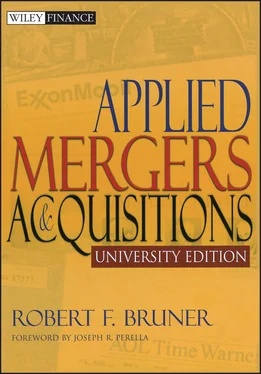The task of listening to firms and industries is to find valuable exceptions to the standard order of things. Graphs and frameworks of industry positioning, such as those outlined in Chapter 6, are useful ways of identifying gaps in markets and the firm’s stance relative to other players. Focusing strictly on the firm, one can look for exceptions by functional area:
Sales and marketing. Look for changes in the positioning of products in stores, specifically the number of “facings” of a product on store shelves, the use of coupons and discounts, and other special promotions. Significant changes in advertising content, placement, and amount may signal a change in strategy. A surge in want ads for field representatives or word of layoffs could also signal a change in the reliance on alternative channels of distribution. The word-of-mouth reputation of a product, particularly if it is new, might indicate promising growth opportunities for the company.
R&D. Patent filings, solicitation of product test sites, and new product announcements convey information about a firm’s research and development (R&D) capabilities, and may become the seed of an important economic anomaly.
Manufacturing. Want ads or announcements of layoffs, major plant construction, plant closings, or land purchases may convey interesting anomalies relative to the general perception about a firm’s ongoing volume of business. Collective bargaining agreements that vary markedly from standard industry practice may constitute interesting exceptions.
Finance. Exceptional increases or decreases in earnings, dividends or cash flow, major new issues or repurchases of debt or equity, and major capital expenditures warrant closer scrutiny. Securities analysts may issue surprising revisions in their recommendations about the target’s debt or equity. A comparative analysis of financial ratios and valuation multiples may suggest that a firm deviates from industry practice in important ways.
1 1. It is useful to focus on constant dollar values in order to net out the possibly spurious effect of inflation or deflation. Over very long periods, even a slow rate of inflation can seriously distort the data. For instance, $100 of nominal purchasing power in 1996 could acquire the same basket of goods as $20 in 1895.
2 2. Brealey and Myers (1996), page 997.
3 3. Such “paradigm shift” deals would include Exxon/Mobil, AOL/Time Warner, WorldCom/MCI, Travelers/Citicorp, Daimler/Chrysler, Vodafone/Mannesmann. Characteristic of all of these was a redefinition of conventional thinking about size of transaction, industry focus, kinds of synergies, and antitrust regulation.
4 4. Melicher, Ledolter, and D’Antonio (1983) and Becketti (1986).
5 5. Weston (1953), Markham (1955), Nelson (1959), Melicher, Ledolter, and D’Antonio (1983), and Becketti (1986).
6 6. Nelson (1959 and 1966) concludes that peaks in M&A activity lead stock market peaks; Melicher, Ledolter, and D’Antonio (1983) conclude that M&A lags the market.
7 7. Self-interested risk management makes decisions based not on the welfare of shareholders, but on the welfare of management. Thus, management might choose to carry large balances of cash, inventory, and fixed assets; reduce the use of debt; and resist proposals to introduce new products or enter new markets—all out of a desire to reduce volatility in the life of managers even though such actions might impose an opportunity cost on shareholders.
8 8. This table follows the suggestion of Shleifer and Vishny (2002) quoted earlier.
9 9. With benefit of 60 years’ hindsight, the echoing conclusions of Schumpeter’s best-known book, Capitalism, Socialism, and Democracy (1947) are wrong. He wrote, “Can capitalism survive? No. I do not think it can…. Can socialism work? Of course it can.” Perhaps in the fullness of time, history will reach his conclusion, though I doubt it. The basis for his conclusion was that capitalism creates so much internal turbulence in society that it will ultimately destroy the values and institutions that preserve it. He also believed that as the capitalist economy grows, ever-larger corporations will emerge—he argued that ultimately this would force the boisterous entrepreneur to adapt to working in a state bureaucracy, and that ultimately socialism could work. Any student of the collapse of the former Soviet Union and satellites, and of the economic rise of the West after World War II, however, would conclude otherwise.
10 10. With remarkable prescience, Schumpeter paints a profile of the entrepreneur that describes well many M&A professionals I have known: “First of all, there is the dream and the will to found a private kingdom, usually, though not necessarily, also a dynasty…. Then there is the will to conquer; the impulse to fight, to prove oneself superior to others, to succeed for the sake, not of the fruits of success, but of success itself…. Finally there is the joy of creating, of getting things done, or simply of exercising one’s energy and ingenuity.” (Theory of Economic Development, 1947, pages 93–94.)
11 11. Schumpeter (1950), page 132.
12 12. Schumpeter (1947), page 255.
13 13. Schumpeter (1950), pages 82– 84.
14 14. Lamoreaux (1988), page 158.
15 15. Ibid., pages 187–188.
16 16. Wasserstein (1998), pages 2–3.
17 17. Ibid., page 163.
18 18. The discussion in this section focuses on “effective yields” (or the annualized internal rate of return on the debt instrument), not coupon yields (or the stated return on the face of the bond).
19 19. Firms assume reinvestment risk where the life of liabilities is greater than the life of assets. Conversely, firms assume refinancing risk where the life of liabilities is less than the life of assets.
CHAPTER 5 Cross-Border M&A
INTRODUCTION
This chapter explores the special M&A perspectives where the buyer and target firm are in different countries. This complements several chapters as the cross-border deal raises especially difficult questions about strategy, valuation, deal design, and implementation. The M&A practitioner should master the perspective of cross-border deals because they:
Are significant. The volume of cross-border M&A activity is large, whether judged in terms of number of deals or value. The formation of trade blocs and regional associations hastens the growth in volume. And the volume of activity is likely to get bigger as country and regional markets integrate into the global market.
Can be disruptive. In many countries and regions, cross-border M&A activity produces big surprises in the form of unanticipated entry by buyers, higher purchase prices, and changes in strategic assumptions about a local market.
Can be motivated by a range of factors, different from domestic deals. These factors include growth by market expansion, extension of technology and brands, acquisition of special resources, tax and currency arbitrage, and the benefits of international diversification. This chapter will outline a number of these motives and summarize research on their effects.
Entail a fundamental bet on countries. Countries differ in important ways that will affect the values of firms. Beneath every cross-border valuation analysis is some hidden assumption or bet about the future of a country market. Since 1945, local product and financial markets have trended toward greater integration with global markets. Integration brings with it economic benefits as well as costs to the local markets and institutions. One should have a view about the direction and pace of integration within home and foreign countries. This chapter will sketch some steps for country analysis.
Affect analysis. It is a mistake to think that cross-border M&A is like domestic M&A, but with different-looking currency. In fact, going across borders requires adjustments in the valuation frameworks and analysis that one takes for granted in assessing domestic deals. Necessary adjustments in cash flows and discount rates can change the conclusions about a deal dramatically. Chapter 13discusses the special adjustments for valuation across borders.
Читать дальше












